Analyzing Performance Measures in Operations: Green Restaurant Report
VerifiedAdded on 2023/05/28
|11
|2399
|221
Report
AI Summary
This report provides a comprehensive analysis of performance measures in the context of a restaurant operation. It begins with an introduction to the importance of performance measures, followed by an examination of management and service provision using transformational process diagrams. The operational process is then explored through a value stream map, highlighting key activities and their impact. The report delves into specific performance measures including quality, cost, speed, flexibility, and dependability, offering insights into how these metrics can be evaluated and improved. It also provides an understanding derived from the evaluation of the organization and proposes improvement plans for the restaurant's operation, focusing on planning and innovation. The report concludes with a summary of findings and references.
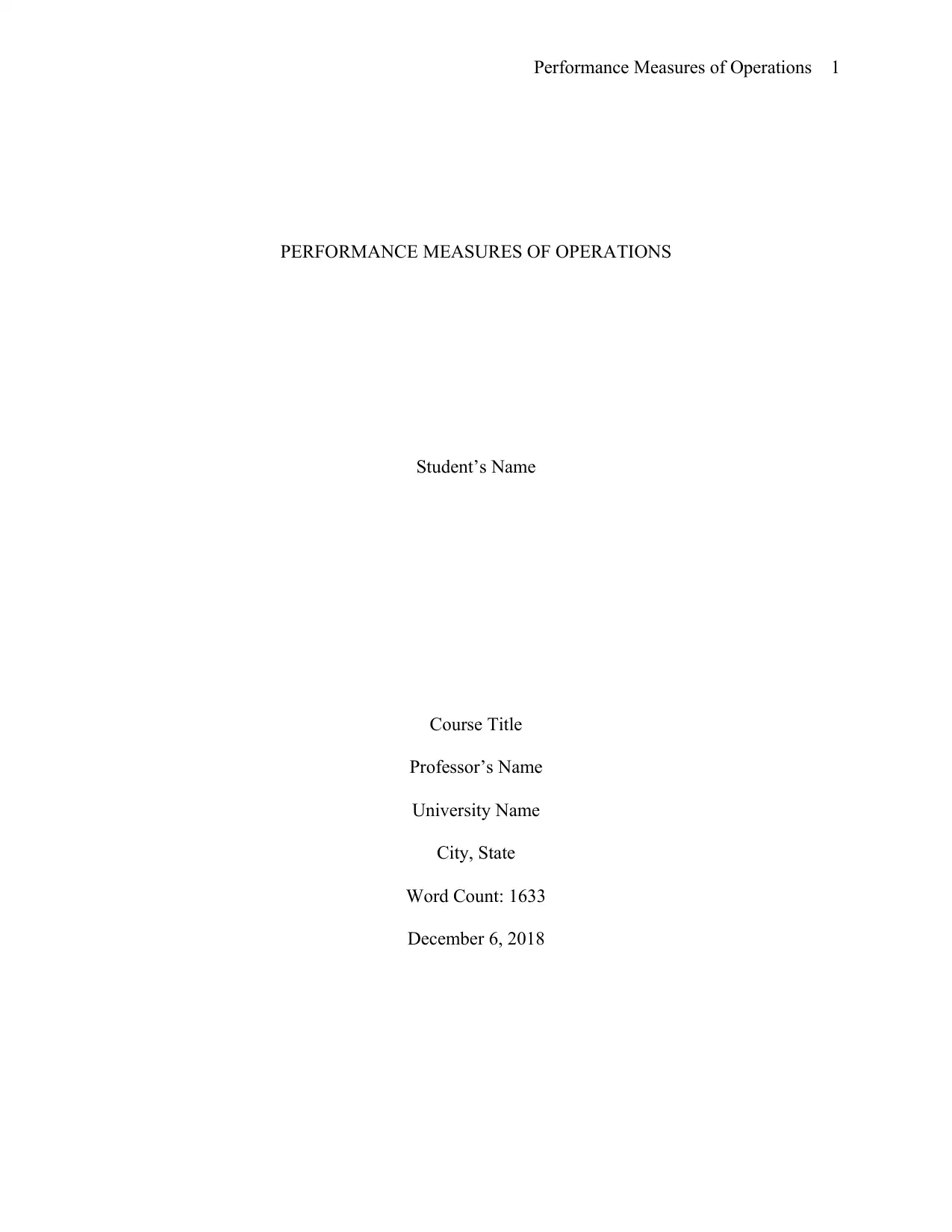
Performance Measures of Operations 1
PERFORMANCE MEASURES OF OPERATIONS
Student’s Name
Course Title
Professor’s Name
University Name
City, State
Word Count: 1633
December 6, 2018
PERFORMANCE MEASURES OF OPERATIONS
Student’s Name
Course Title
Professor’s Name
University Name
City, State
Word Count: 1633
December 6, 2018
Paraphrase This Document
Need a fresh take? Get an instant paraphrase of this document with our AI Paraphraser
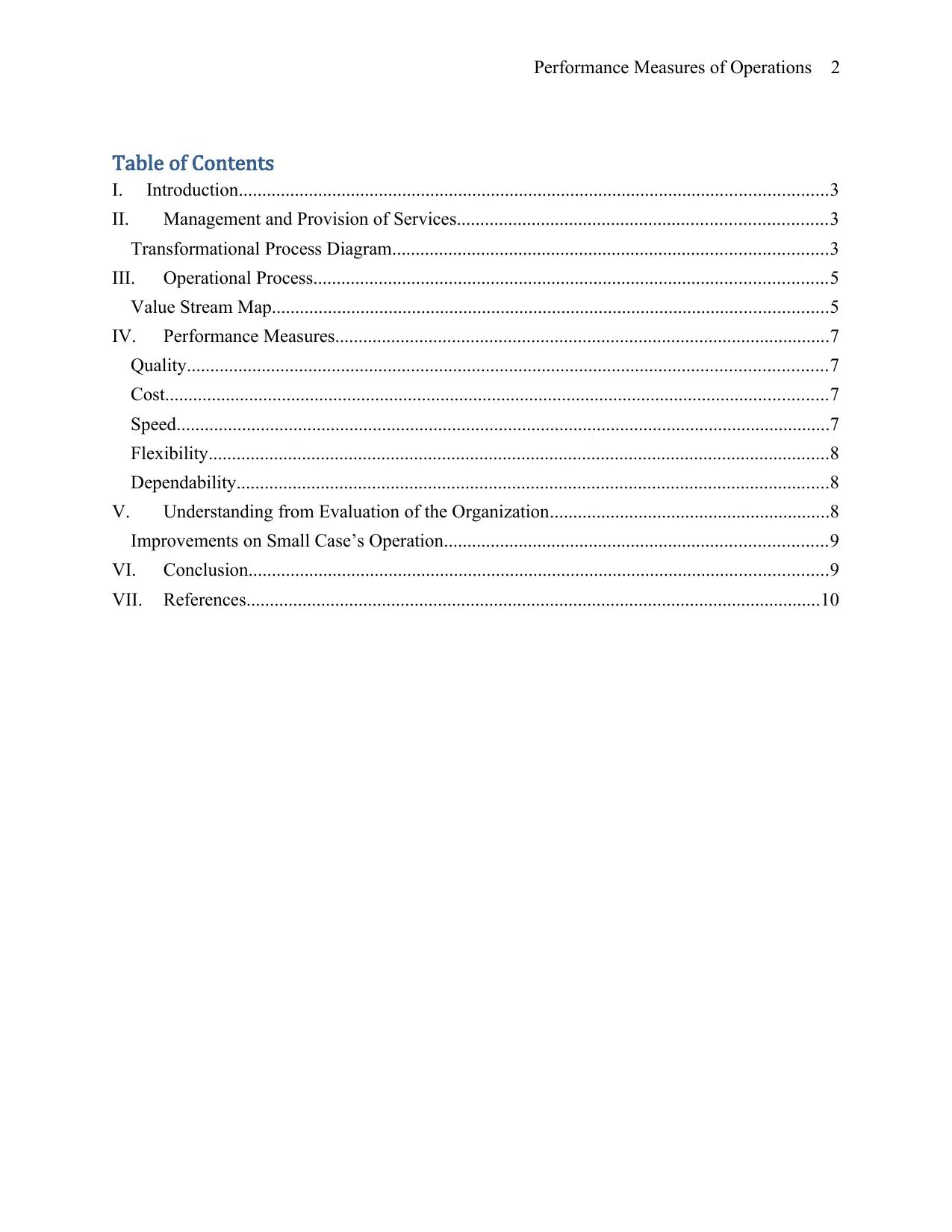
Performance Measures of Operations 2
Table of Contents
I. Introduction..............................................................................................................................3
II. Management and Provision of Services...............................................................................3
Transformational Process Diagram.............................................................................................3
III. Operational Process..............................................................................................................5
Value Stream Map.......................................................................................................................5
IV. Performance Measures..........................................................................................................7
Quality.........................................................................................................................................7
Cost..............................................................................................................................................7
Speed............................................................................................................................................7
Flexibility.....................................................................................................................................8
Dependability...............................................................................................................................8
V. Understanding from Evaluation of the Organization............................................................8
Improvements on Small Case’s Operation..................................................................................9
VI. Conclusion............................................................................................................................9
VII. References...........................................................................................................................10
Table of Contents
I. Introduction..............................................................................................................................3
II. Management and Provision of Services...............................................................................3
Transformational Process Diagram.............................................................................................3
III. Operational Process..............................................................................................................5
Value Stream Map.......................................................................................................................5
IV. Performance Measures..........................................................................................................7
Quality.........................................................................................................................................7
Cost..............................................................................................................................................7
Speed............................................................................................................................................7
Flexibility.....................................................................................................................................8
Dependability...............................................................................................................................8
V. Understanding from Evaluation of the Organization............................................................8
Improvements on Small Case’s Operation..................................................................................9
VI. Conclusion............................................................................................................................9
VII. References...........................................................................................................................10
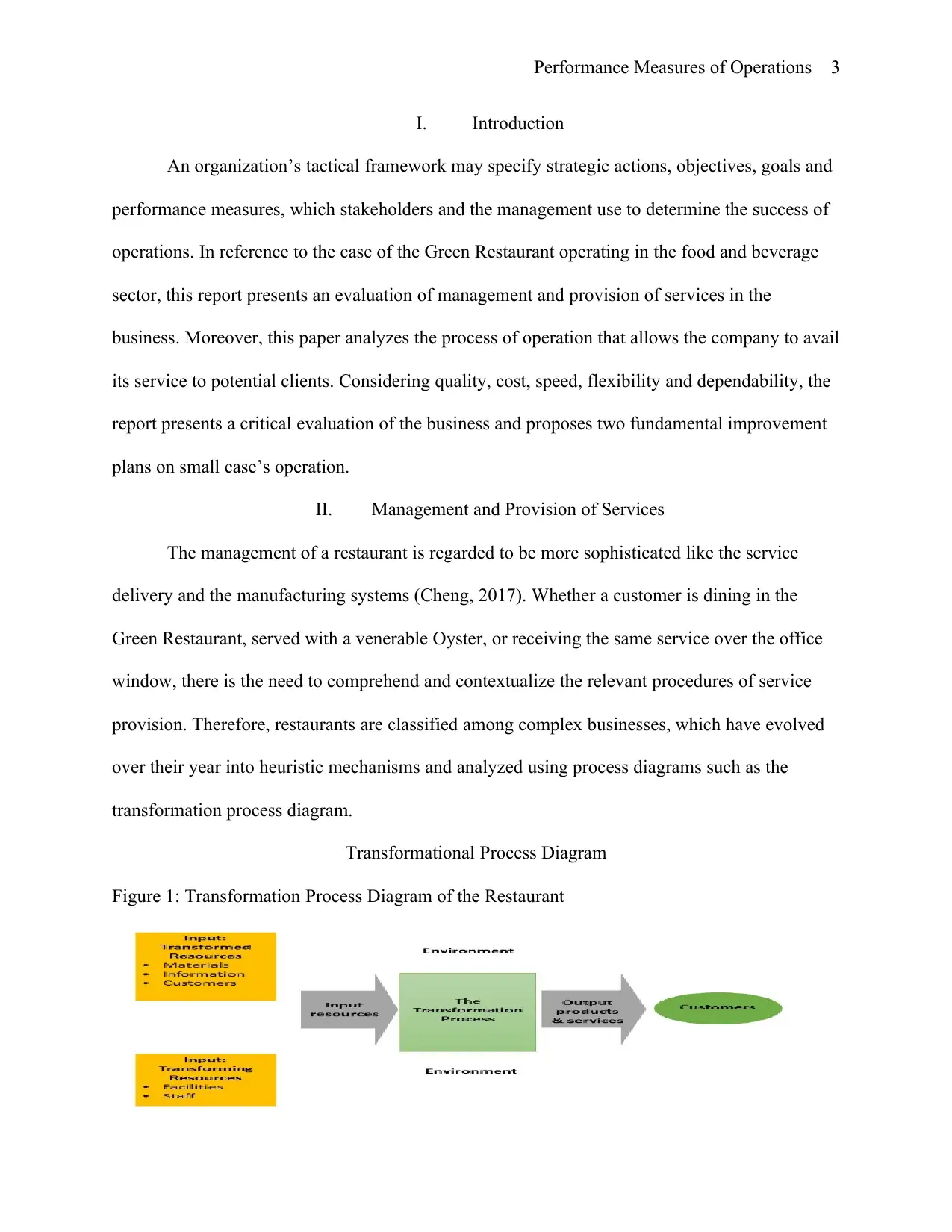
Performance Measures of Operations 3
I. Introduction
An organization’s tactical framework may specify strategic actions, objectives, goals and
performance measures, which stakeholders and the management use to determine the success of
operations. In reference to the case of the Green Restaurant operating in the food and beverage
sector, this report presents an evaluation of management and provision of services in the
business. Moreover, this paper analyzes the process of operation that allows the company to avail
its service to potential clients. Considering quality, cost, speed, flexibility and dependability, the
report presents a critical evaluation of the business and proposes two fundamental improvement
plans on small case’s operation.
II. Management and Provision of Services
The management of a restaurant is regarded to be more sophisticated like the service
delivery and the manufacturing systems (Cheng, 2017). Whether a customer is dining in the
Green Restaurant, served with a venerable Oyster, or receiving the same service over the office
window, there is the need to comprehend and contextualize the relevant procedures of service
provision. Therefore, restaurants are classified among complex businesses, which have evolved
over their year into heuristic mechanisms and analyzed using process diagrams such as the
transformation process diagram.
Transformational Process Diagram
Figure 1: Transformation Process Diagram of the Restaurant
I. Introduction
An organization’s tactical framework may specify strategic actions, objectives, goals and
performance measures, which stakeholders and the management use to determine the success of
operations. In reference to the case of the Green Restaurant operating in the food and beverage
sector, this report presents an evaluation of management and provision of services in the
business. Moreover, this paper analyzes the process of operation that allows the company to avail
its service to potential clients. Considering quality, cost, speed, flexibility and dependability, the
report presents a critical evaluation of the business and proposes two fundamental improvement
plans on small case’s operation.
II. Management and Provision of Services
The management of a restaurant is regarded to be more sophisticated like the service
delivery and the manufacturing systems (Cheng, 2017). Whether a customer is dining in the
Green Restaurant, served with a venerable Oyster, or receiving the same service over the office
window, there is the need to comprehend and contextualize the relevant procedures of service
provision. Therefore, restaurants are classified among complex businesses, which have evolved
over their year into heuristic mechanisms and analyzed using process diagrams such as the
transformation process diagram.
Transformational Process Diagram
Figure 1: Transformation Process Diagram of the Restaurant
⊘ This is a preview!⊘
Do you want full access?
Subscribe today to unlock all pages.

Trusted by 1+ million students worldwide
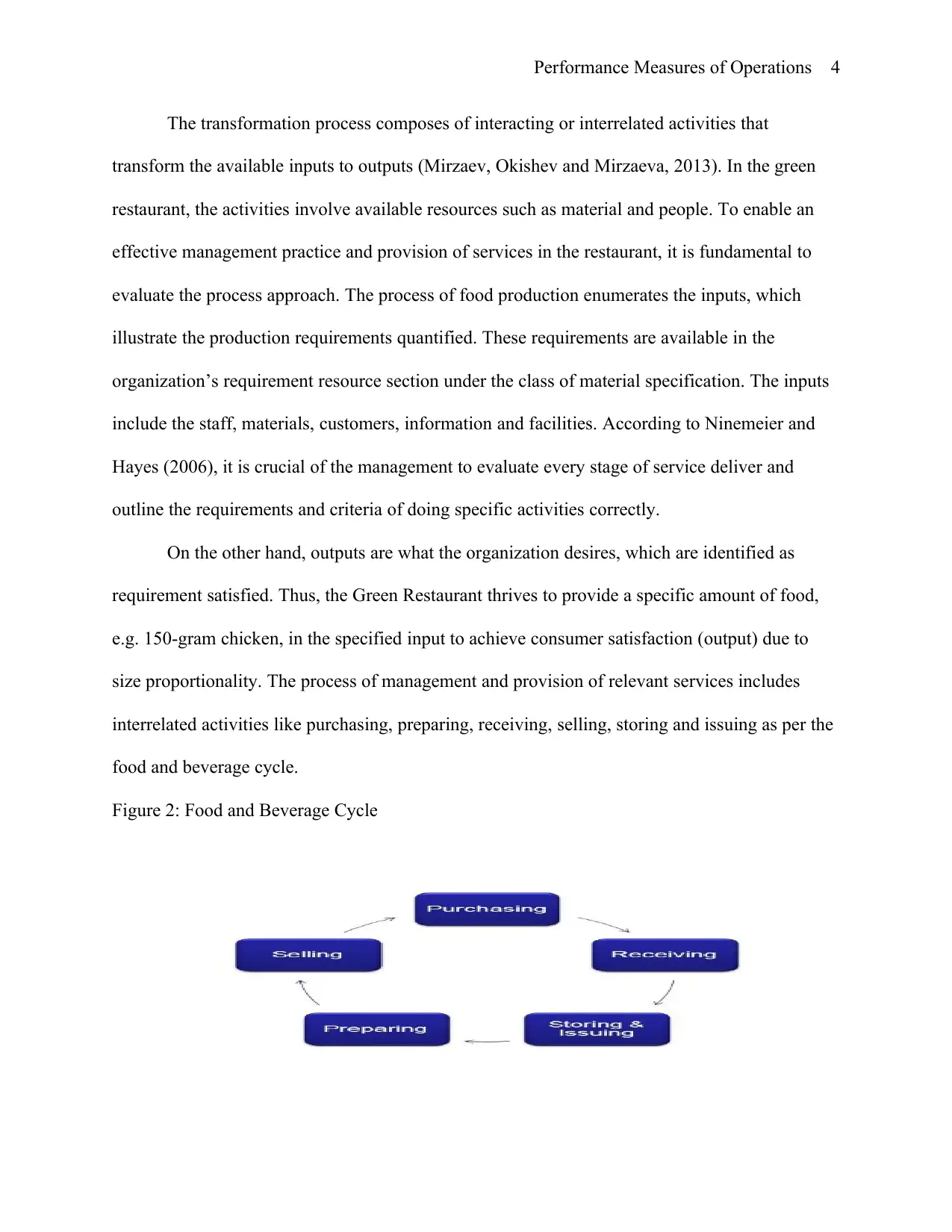
Performance Measures of Operations 4
The transformation process composes of interacting or interrelated activities that
transform the available inputs to outputs (Mirzaev, Okishev and Mirzaeva, 2013). In the green
restaurant, the activities involve available resources such as material and people. To enable an
effective management practice and provision of services in the restaurant, it is fundamental to
evaluate the process approach. The process of food production enumerates the inputs, which
illustrate the production requirements quantified. These requirements are available in the
organization’s requirement resource section under the class of material specification. The inputs
include the staff, materials, customers, information and facilities. According to Ninemeier and
Hayes (2006), it is crucial of the management to evaluate every stage of service deliver and
outline the requirements and criteria of doing specific activities correctly.
On the other hand, outputs are what the organization desires, which are identified as
requirement satisfied. Thus, the Green Restaurant thrives to provide a specific amount of food,
e.g. 150-gram chicken, in the specified input to achieve consumer satisfaction (output) due to
size proportionality. The process of management and provision of relevant services includes
interrelated activities like purchasing, preparing, receiving, selling, storing and issuing as per the
food and beverage cycle.
Figure 2: Food and Beverage Cycle
The transformation process composes of interacting or interrelated activities that
transform the available inputs to outputs (Mirzaev, Okishev and Mirzaeva, 2013). In the green
restaurant, the activities involve available resources such as material and people. To enable an
effective management practice and provision of services in the restaurant, it is fundamental to
evaluate the process approach. The process of food production enumerates the inputs, which
illustrate the production requirements quantified. These requirements are available in the
organization’s requirement resource section under the class of material specification. The inputs
include the staff, materials, customers, information and facilities. According to Ninemeier and
Hayes (2006), it is crucial of the management to evaluate every stage of service deliver and
outline the requirements and criteria of doing specific activities correctly.
On the other hand, outputs are what the organization desires, which are identified as
requirement satisfied. Thus, the Green Restaurant thrives to provide a specific amount of food,
e.g. 150-gram chicken, in the specified input to achieve consumer satisfaction (output) due to
size proportionality. The process of management and provision of relevant services includes
interrelated activities like purchasing, preparing, receiving, selling, storing and issuing as per the
food and beverage cycle.
Figure 2: Food and Beverage Cycle
Paraphrase This Document
Need a fresh take? Get an instant paraphrase of this document with our AI Paraphraser
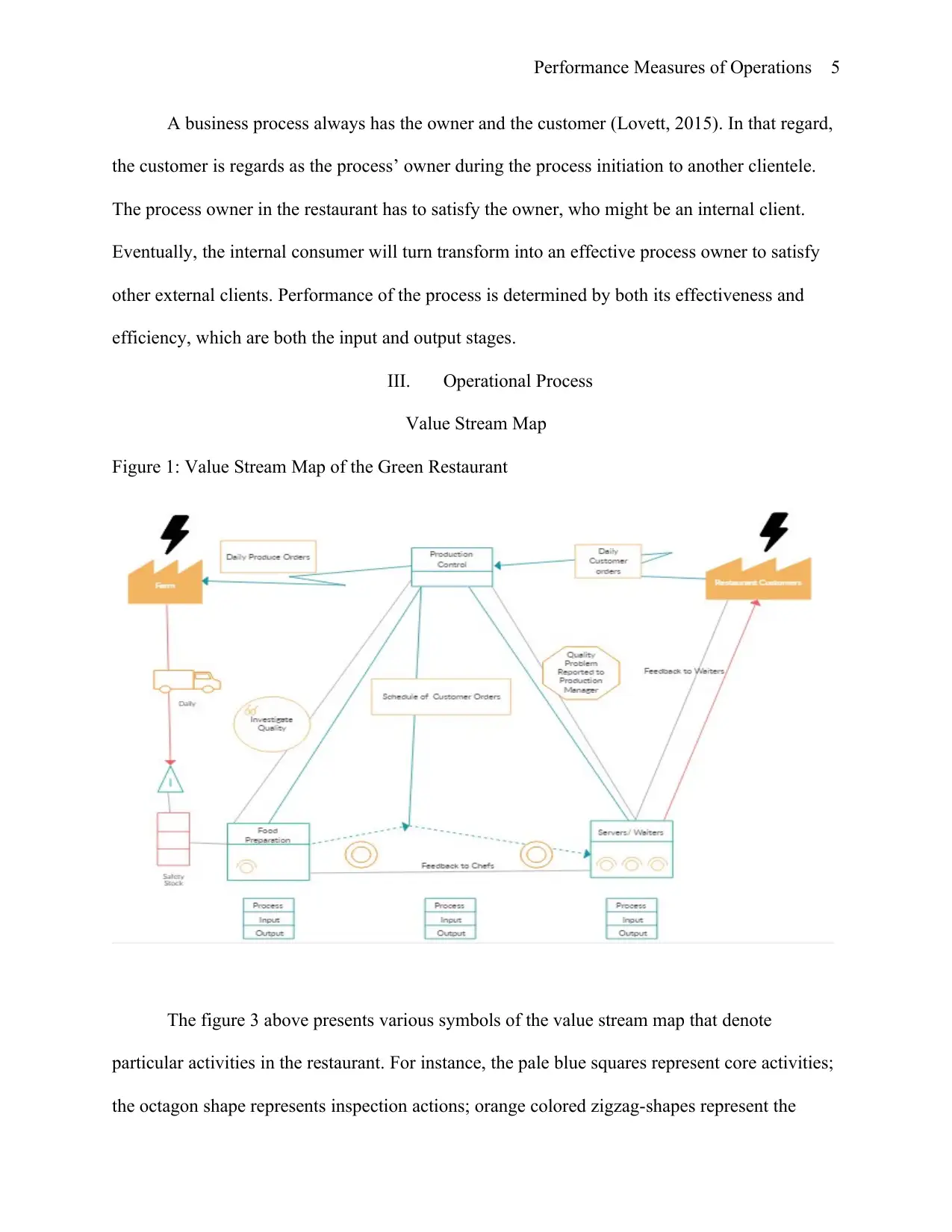
Performance Measures of Operations 5
A business process always has the owner and the customer (Lovett, 2015). In that regard,
the customer is regards as the process’ owner during the process initiation to another clientele.
The process owner in the restaurant has to satisfy the owner, who might be an internal client.
Eventually, the internal consumer will turn transform into an effective process owner to satisfy
other external clients. Performance of the process is determined by both its effectiveness and
efficiency, which are both the input and output stages.
III. Operational Process
Value Stream Map
Figure 1: Value Stream Map of the Green Restaurant
The figure 3 above presents various symbols of the value stream map that denote
particular activities in the restaurant. For instance, the pale blue squares represent core activities;
the octagon shape represents inspection actions; orange colored zigzag-shapes represent the
A business process always has the owner and the customer (Lovett, 2015). In that regard,
the customer is regards as the process’ owner during the process initiation to another clientele.
The process owner in the restaurant has to satisfy the owner, who might be an internal client.
Eventually, the internal consumer will turn transform into an effective process owner to satisfy
other external clients. Performance of the process is determined by both its effectiveness and
efficiency, which are both the input and output stages.
III. Operational Process
Value Stream Map
Figure 1: Value Stream Map of the Green Restaurant
The figure 3 above presents various symbols of the value stream map that denote
particular activities in the restaurant. For instance, the pale blue squares represent core activities;
the octagon shape represents inspection actions; orange colored zigzag-shapes represent the
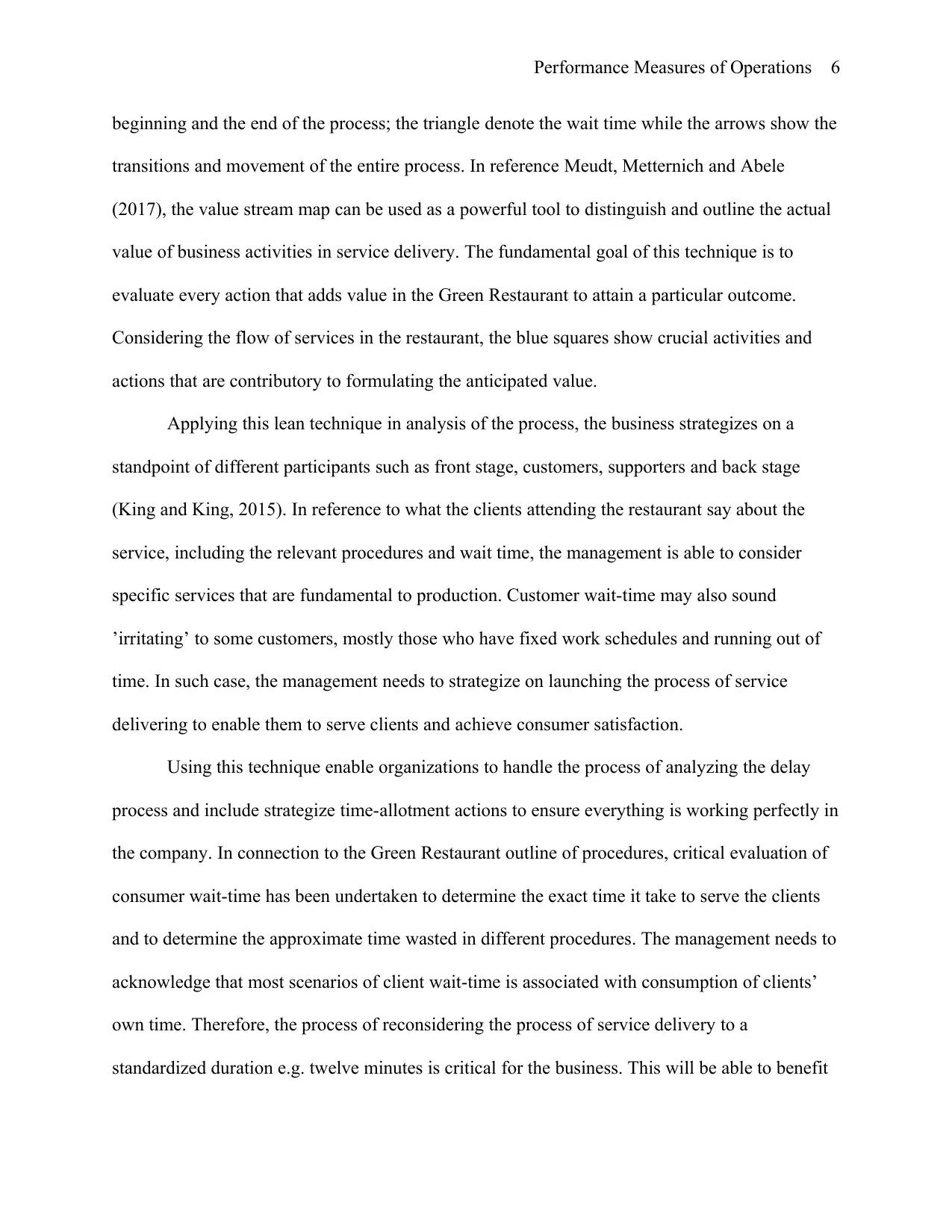
Performance Measures of Operations 6
beginning and the end of the process; the triangle denote the wait time while the arrows show the
transitions and movement of the entire process. In reference Meudt, Metternich and Abele
(2017), the value stream map can be used as a powerful tool to distinguish and outline the actual
value of business activities in service delivery. The fundamental goal of this technique is to
evaluate every action that adds value in the Green Restaurant to attain a particular outcome.
Considering the flow of services in the restaurant, the blue squares show crucial activities and
actions that are contributory to formulating the anticipated value.
Applying this lean technique in analysis of the process, the business strategizes on a
standpoint of different participants such as front stage, customers, supporters and back stage
(King and King, 2015). In reference to what the clients attending the restaurant say about the
service, including the relevant procedures and wait time, the management is able to consider
specific services that are fundamental to production. Customer wait-time may also sound
’irritating’ to some customers, mostly those who have fixed work schedules and running out of
time. In such case, the management needs to strategize on launching the process of service
delivering to enable them to serve clients and achieve consumer satisfaction.
Using this technique enable organizations to handle the process of analyzing the delay
process and include strategize time-allotment actions to ensure everything is working perfectly in
the company. In connection to the Green Restaurant outline of procedures, critical evaluation of
consumer wait-time has been undertaken to determine the exact time it take to serve the clients
and to determine the approximate time wasted in different procedures. The management needs to
acknowledge that most scenarios of client wait-time is associated with consumption of clients’
own time. Therefore, the process of reconsidering the process of service delivery to a
standardized duration e.g. twelve minutes is critical for the business. This will be able to benefit
beginning and the end of the process; the triangle denote the wait time while the arrows show the
transitions and movement of the entire process. In reference Meudt, Metternich and Abele
(2017), the value stream map can be used as a powerful tool to distinguish and outline the actual
value of business activities in service delivery. The fundamental goal of this technique is to
evaluate every action that adds value in the Green Restaurant to attain a particular outcome.
Considering the flow of services in the restaurant, the blue squares show crucial activities and
actions that are contributory to formulating the anticipated value.
Applying this lean technique in analysis of the process, the business strategizes on a
standpoint of different participants such as front stage, customers, supporters and back stage
(King and King, 2015). In reference to what the clients attending the restaurant say about the
service, including the relevant procedures and wait time, the management is able to consider
specific services that are fundamental to production. Customer wait-time may also sound
’irritating’ to some customers, mostly those who have fixed work schedules and running out of
time. In such case, the management needs to strategize on launching the process of service
delivering to enable them to serve clients and achieve consumer satisfaction.
Using this technique enable organizations to handle the process of analyzing the delay
process and include strategize time-allotment actions to ensure everything is working perfectly in
the company. In connection to the Green Restaurant outline of procedures, critical evaluation of
consumer wait-time has been undertaken to determine the exact time it take to serve the clients
and to determine the approximate time wasted in different procedures. The management needs to
acknowledge that most scenarios of client wait-time is associated with consumption of clients’
own time. Therefore, the process of reconsidering the process of service delivery to a
standardized duration e.g. twelve minutes is critical for the business. This will be able to benefit
⊘ This is a preview!⊘
Do you want full access?
Subscribe today to unlock all pages.

Trusted by 1+ million students worldwide
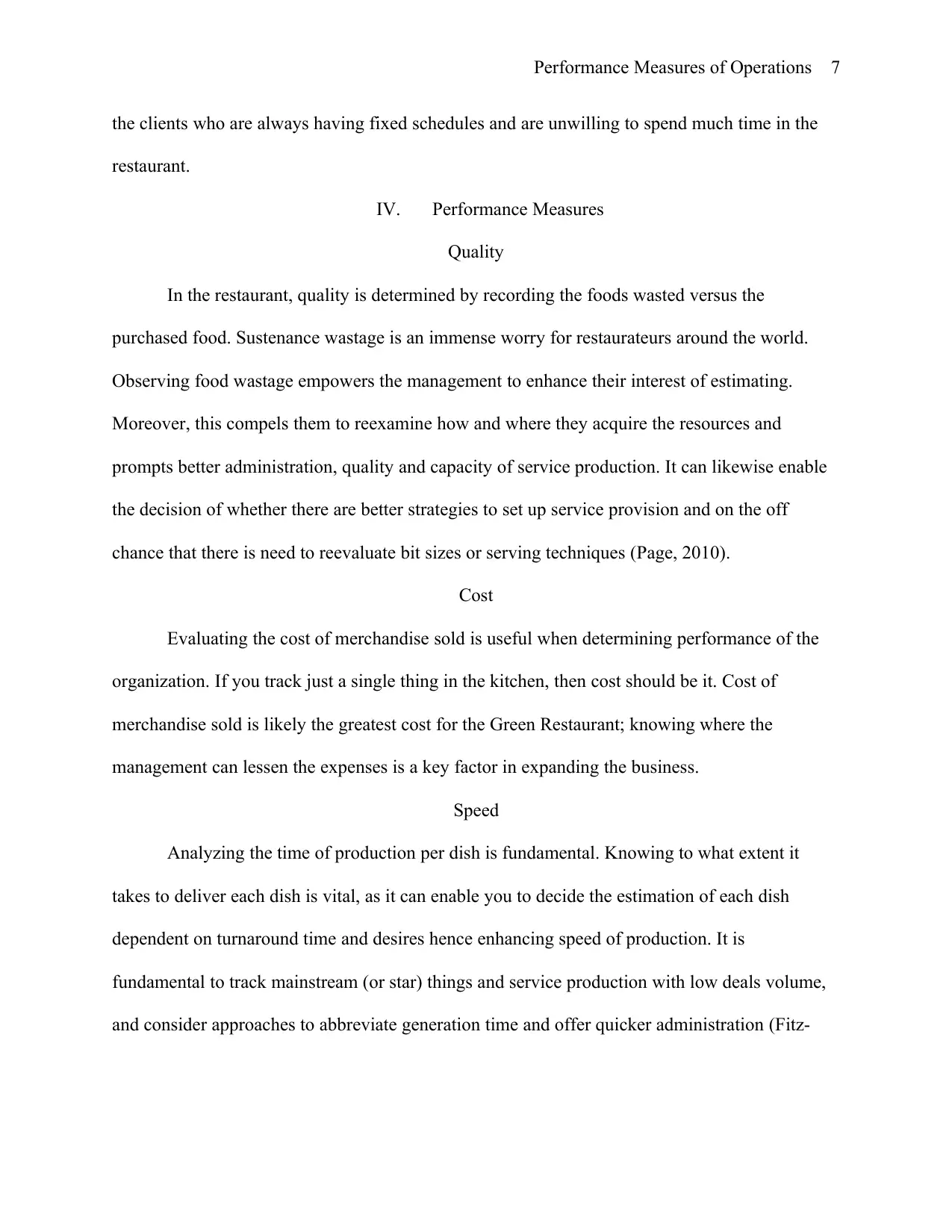
Performance Measures of Operations 7
the clients who are always having fixed schedules and are unwilling to spend much time in the
restaurant.
IV. Performance Measures
Quality
In the restaurant, quality is determined by recording the foods wasted versus the
purchased food. Sustenance wastage is an immense worry for restaurateurs around the world.
Observing food wastage empowers the management to enhance their interest of estimating.
Moreover, this compels them to reexamine how and where they acquire the resources and
prompts better administration, quality and capacity of service production. It can likewise enable
the decision of whether there are better strategies to set up service provision and on the off
chance that there is need to reevaluate bit sizes or serving techniques (Page, 2010).
Cost
Evaluating the cost of merchandise sold is useful when determining performance of the
organization. If you track just a single thing in the kitchen, then cost should be it. Cost of
merchandise sold is likely the greatest cost for the Green Restaurant; knowing where the
management can lessen the expenses is a key factor in expanding the business.
Speed
Analyzing the time of production per dish is fundamental. Knowing to what extent it
takes to deliver each dish is vital, as it can enable you to decide the estimation of each dish
dependent on turnaround time and desires hence enhancing speed of production. It is
fundamental to track mainstream (or star) things and service production with low deals volume,
and consider approaches to abbreviate generation time and offer quicker administration (Fitz-
the clients who are always having fixed schedules and are unwilling to spend much time in the
restaurant.
IV. Performance Measures
Quality
In the restaurant, quality is determined by recording the foods wasted versus the
purchased food. Sustenance wastage is an immense worry for restaurateurs around the world.
Observing food wastage empowers the management to enhance their interest of estimating.
Moreover, this compels them to reexamine how and where they acquire the resources and
prompts better administration, quality and capacity of service production. It can likewise enable
the decision of whether there are better strategies to set up service provision and on the off
chance that there is need to reevaluate bit sizes or serving techniques (Page, 2010).
Cost
Evaluating the cost of merchandise sold is useful when determining performance of the
organization. If you track just a single thing in the kitchen, then cost should be it. Cost of
merchandise sold is likely the greatest cost for the Green Restaurant; knowing where the
management can lessen the expenses is a key factor in expanding the business.
Speed
Analyzing the time of production per dish is fundamental. Knowing to what extent it
takes to deliver each dish is vital, as it can enable you to decide the estimation of each dish
dependent on turnaround time and desires hence enhancing speed of production. It is
fundamental to track mainstream (or star) things and service production with low deals volume,
and consider approaches to abbreviate generation time and offer quicker administration (Fitz-
Paraphrase This Document
Need a fresh take? Get an instant paraphrase of this document with our AI Paraphraser
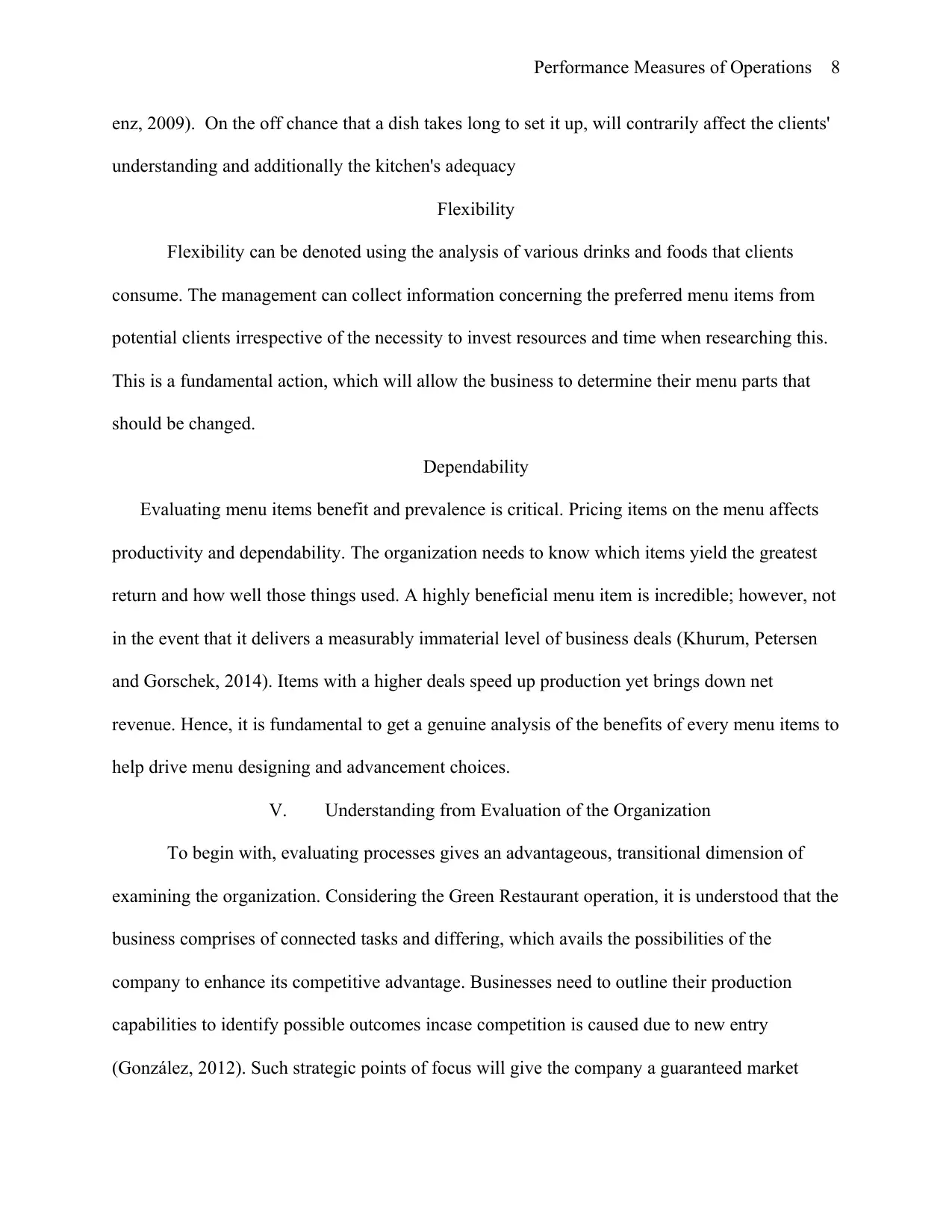
Performance Measures of Operations 8
enz, 2009). On the off chance that a dish takes long to set it up, will contrarily affect the clients'
understanding and additionally the kitchen's adequacy
Flexibility
Flexibility can be denoted using the analysis of various drinks and foods that clients
consume. The management can collect information concerning the preferred menu items from
potential clients irrespective of the necessity to invest resources and time when researching this.
This is a fundamental action, which will allow the business to determine their menu parts that
should be changed.
Dependability
Evaluating menu items benefit and prevalence is critical. Pricing items on the menu affects
productivity and dependability. The organization needs to know which items yield the greatest
return and how well those things used. A highly beneficial menu item is incredible; however, not
in the event that it delivers a measurably immaterial level of business deals (Khurum, Petersen
and Gorschek, 2014). Items with a higher deals speed up production yet brings down net
revenue. Hence, it is fundamental to get a genuine analysis of the benefits of every menu items to
help drive menu designing and advancement choices.
V. Understanding from Evaluation of the Organization
To begin with, evaluating processes gives an advantageous, transitional dimension of
examining the organization. Considering the Green Restaurant operation, it is understood that the
business comprises of connected tasks and differing, which avails the possibilities of the
company to enhance its competitive advantage. Businesses need to outline their production
capabilities to identify possible outcomes incase competition is caused due to new entry
(González, 2012). Such strategic points of focus will give the company a guaranteed market
enz, 2009). On the off chance that a dish takes long to set it up, will contrarily affect the clients'
understanding and additionally the kitchen's adequacy
Flexibility
Flexibility can be denoted using the analysis of various drinks and foods that clients
consume. The management can collect information concerning the preferred menu items from
potential clients irrespective of the necessity to invest resources and time when researching this.
This is a fundamental action, which will allow the business to determine their menu parts that
should be changed.
Dependability
Evaluating menu items benefit and prevalence is critical. Pricing items on the menu affects
productivity and dependability. The organization needs to know which items yield the greatest
return and how well those things used. A highly beneficial menu item is incredible; however, not
in the event that it delivers a measurably immaterial level of business deals (Khurum, Petersen
and Gorschek, 2014). Items with a higher deals speed up production yet brings down net
revenue. Hence, it is fundamental to get a genuine analysis of the benefits of every menu items to
help drive menu designing and advancement choices.
V. Understanding from Evaluation of the Organization
To begin with, evaluating processes gives an advantageous, transitional dimension of
examining the organization. Considering the Green Restaurant operation, it is understood that the
business comprises of connected tasks and differing, which avails the possibilities of the
company to enhance its competitive advantage. Businesses need to outline their production
capabilities to identify possible outcomes incase competition is caused due to new entry
(González, 2012). Such strategic points of focus will give the company a guaranteed market
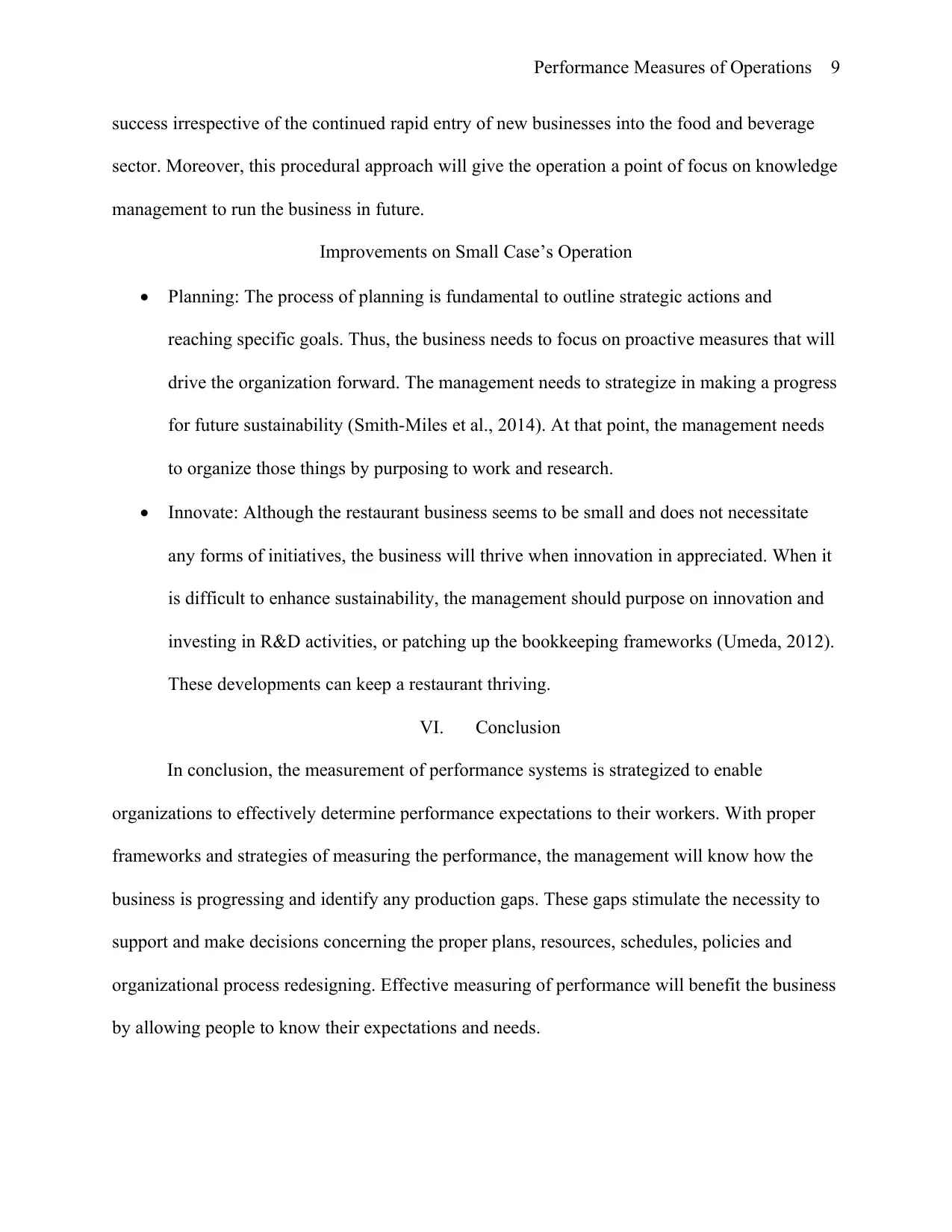
Performance Measures of Operations 9
success irrespective of the continued rapid entry of new businesses into the food and beverage
sector. Moreover, this procedural approach will give the operation a point of focus on knowledge
management to run the business in future.
Improvements on Small Case’s Operation
Planning: The process of planning is fundamental to outline strategic actions and
reaching specific goals. Thus, the business needs to focus on proactive measures that will
drive the organization forward. The management needs to strategize in making a progress
for future sustainability (Smith-Miles et al., 2014). At that point, the management needs
to organize those things by purposing to work and research.
Innovate: Although the restaurant business seems to be small and does not necessitate
any forms of initiatives, the business will thrive when innovation in appreciated. When it
is difficult to enhance sustainability, the management should purpose on innovation and
investing in R&D activities, or patching up the bookkeeping frameworks (Umeda, 2012).
These developments can keep a restaurant thriving.
VI. Conclusion
In conclusion, the measurement of performance systems is strategized to enable
organizations to effectively determine performance expectations to their workers. With proper
frameworks and strategies of measuring the performance, the management will know how the
business is progressing and identify any production gaps. These gaps stimulate the necessity to
support and make decisions concerning the proper plans, resources, schedules, policies and
organizational process redesigning. Effective measuring of performance will benefit the business
by allowing people to know their expectations and needs.
success irrespective of the continued rapid entry of new businesses into the food and beverage
sector. Moreover, this procedural approach will give the operation a point of focus on knowledge
management to run the business in future.
Improvements on Small Case’s Operation
Planning: The process of planning is fundamental to outline strategic actions and
reaching specific goals. Thus, the business needs to focus on proactive measures that will
drive the organization forward. The management needs to strategize in making a progress
for future sustainability (Smith-Miles et al., 2014). At that point, the management needs
to organize those things by purposing to work and research.
Innovate: Although the restaurant business seems to be small and does not necessitate
any forms of initiatives, the business will thrive when innovation in appreciated. When it
is difficult to enhance sustainability, the management should purpose on innovation and
investing in R&D activities, or patching up the bookkeeping frameworks (Umeda, 2012).
These developments can keep a restaurant thriving.
VI. Conclusion
In conclusion, the measurement of performance systems is strategized to enable
organizations to effectively determine performance expectations to their workers. With proper
frameworks and strategies of measuring the performance, the management will know how the
business is progressing and identify any production gaps. These gaps stimulate the necessity to
support and make decisions concerning the proper plans, resources, schedules, policies and
organizational process redesigning. Effective measuring of performance will benefit the business
by allowing people to know their expectations and needs.
⊘ This is a preview!⊘
Do you want full access?
Subscribe today to unlock all pages.

Trusted by 1+ million students worldwide
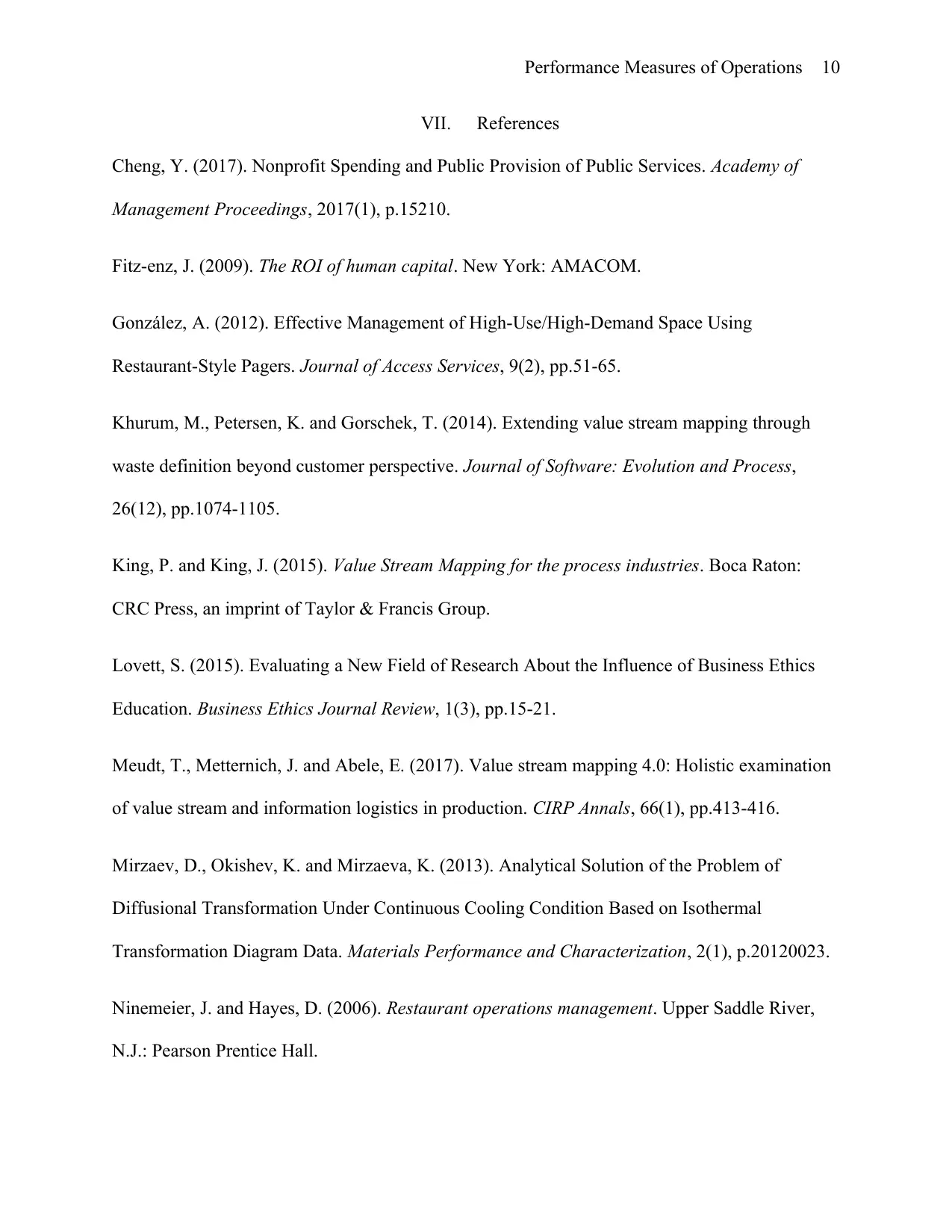
Performance Measures of Operations 10
VII. References
Cheng, Y. (2017). Nonprofit Spending and Public Provision of Public Services. Academy of
Management Proceedings, 2017(1), p.15210.
Fitz-enz, J. (2009). The ROI of human capital. New York: AMACOM.
González, A. (2012). Effective Management of High-Use/High-Demand Space Using
Restaurant-Style Pagers. Journal of Access Services, 9(2), pp.51-65.
Khurum, M., Petersen, K. and Gorschek, T. (2014). Extending value stream mapping through
waste definition beyond customer perspective. Journal of Software: Evolution and Process,
26(12), pp.1074-1105.
King, P. and King, J. (2015). Value Stream Mapping for the process industries. Boca Raton:
CRC Press, an imprint of Taylor & Francis Group.
Lovett, S. (2015). Evaluating a New Field of Research About the Influence of Business Ethics
Education. Business Ethics Journal Review, 1(3), pp.15-21.
Meudt, T., Metternich, J. and Abele, E. (2017). Value stream mapping 4.0: Holistic examination
of value stream and information logistics in production. CIRP Annals, 66(1), pp.413-416.
Mirzaev, D., Okishev, K. and Mirzaeva, K. (2013). Analytical Solution of the Problem of
Diffusional Transformation Under Continuous Cooling Condition Based on Isothermal
Transformation Diagram Data. Materials Performance and Characterization, 2(1), p.20120023.
Ninemeier, J. and Hayes, D. (2006). Restaurant operations management. Upper Saddle River,
N.J.: Pearson Prentice Hall.
VII. References
Cheng, Y. (2017). Nonprofit Spending and Public Provision of Public Services. Academy of
Management Proceedings, 2017(1), p.15210.
Fitz-enz, J. (2009). The ROI of human capital. New York: AMACOM.
González, A. (2012). Effective Management of High-Use/High-Demand Space Using
Restaurant-Style Pagers. Journal of Access Services, 9(2), pp.51-65.
Khurum, M., Petersen, K. and Gorschek, T. (2014). Extending value stream mapping through
waste definition beyond customer perspective. Journal of Software: Evolution and Process,
26(12), pp.1074-1105.
King, P. and King, J. (2015). Value Stream Mapping for the process industries. Boca Raton:
CRC Press, an imprint of Taylor & Francis Group.
Lovett, S. (2015). Evaluating a New Field of Research About the Influence of Business Ethics
Education. Business Ethics Journal Review, 1(3), pp.15-21.
Meudt, T., Metternich, J. and Abele, E. (2017). Value stream mapping 4.0: Holistic examination
of value stream and information logistics in production. CIRP Annals, 66(1), pp.413-416.
Mirzaev, D., Okishev, K. and Mirzaeva, K. (2013). Analytical Solution of the Problem of
Diffusional Transformation Under Continuous Cooling Condition Based on Isothermal
Transformation Diagram Data. Materials Performance and Characterization, 2(1), p.20120023.
Ninemeier, J. and Hayes, D. (2006). Restaurant operations management. Upper Saddle River,
N.J.: Pearson Prentice Hall.
Paraphrase This Document
Need a fresh take? Get an instant paraphrase of this document with our AI Paraphraser
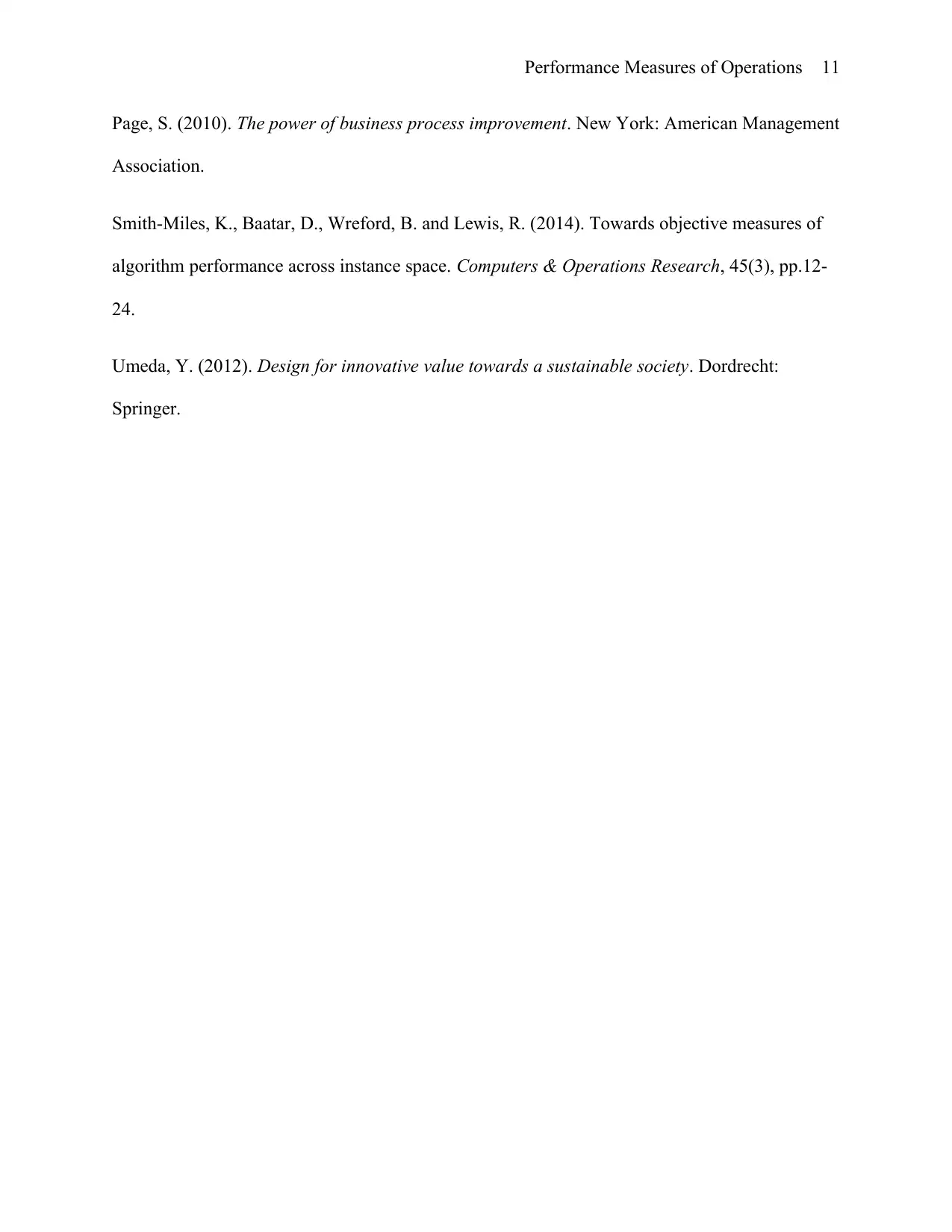
Performance Measures of Operations 11
Page, S. (2010). The power of business process improvement. New York: American Management
Association.
Smith-Miles, K., Baatar, D., Wreford, B. and Lewis, R. (2014). Towards objective measures of
algorithm performance across instance space. Computers & Operations Research, 45(3), pp.12-
24.
Umeda, Y. (2012). Design for innovative value towards a sustainable society. Dordrecht:
Springer.
Page, S. (2010). The power of business process improvement. New York: American Management
Association.
Smith-Miles, K., Baatar, D., Wreford, B. and Lewis, R. (2014). Towards objective measures of
algorithm performance across instance space. Computers & Operations Research, 45(3), pp.12-
24.
Umeda, Y. (2012). Design for innovative value towards a sustainable society. Dordrecht:
Springer.
1 out of 11
Related Documents
Your All-in-One AI-Powered Toolkit for Academic Success.
+13062052269
info@desklib.com
Available 24*7 on WhatsApp / Email
![[object Object]](/_next/static/media/star-bottom.7253800d.svg)
Unlock your academic potential
Copyright © 2020–2025 A2Z Services. All Rights Reserved. Developed and managed by ZUCOL.





